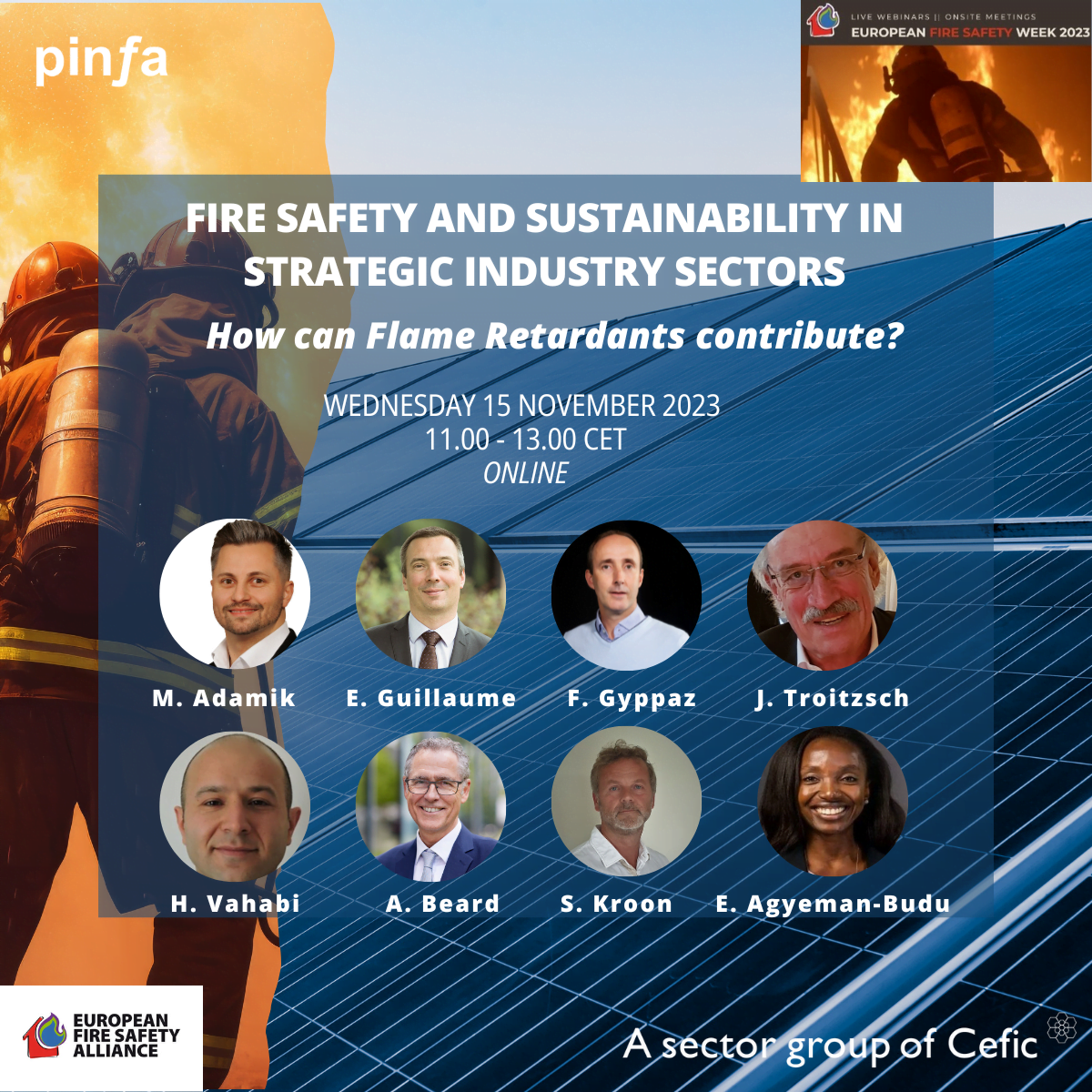
Webinar organised by pinfa, with 75 participants, saw how flame retardants are essential for “Strategic Technologies”. Wed. 15th November, as part of the 5th European Fire Safety Week).
Webinar online replay here “Fire safety and sustainability in strategic industry sectors: how can Flame Retardants contribute?” https://www.pinfa.eu/media-events/presentations
Adrian Beard, pinfa Chairman and Clariant, and Esther Agyeman-Budu, pinfa Director at Cefic, opened the webinar and introduced pinfa.
Sander Kroon, pinfa and ICL: the EU Critical Raw Materials Act (underway) defines strategic technologies as those “needed for the green and digital transitions as well as for defence and space applications”. Fire protection is essential for the safety and the resilience of these technologies. Innovation needs advanced materials such as polymer and composites to enable design flexibility, electrical and mechanical performance and lightweighting – but these advanced materials are inherently flammable. Batteries, ubiquitous electronics and intensive electrical energy, as well as thermal insulation to reduce energy consumption, all pose specific fire safety challenges. Flame retardants are a key part of the fire safety toolbox, preventing fire from starting and from spreading, for example in case of localised electrical overheating or arcing.
Jürgen Troitzsch, Fire and Environment Protection Service FEPS, discussed fire risks related to societal and technology megatrends in electronics (Internet of Things IoT) and mobility (electrification). IoT devices are potential fire ignition sources, through overheating or electrical component failure, and are connected 24/7, so often with no surveillance. Product recalls show that fire safety requirements are often not met, but also that this can have very high costs for both industry and consumers. Fire safety standards for materials used in cars and buses are today outdated and are generally recognised as inadequate, yet vehicle fire risks are increasing with high voltages (power trains) and ubiquitous electronics and electrical equipment and permanent internet connection. Specific new standards are being developed for e.g. batteries, charging stations.
See: “Electrical applications in Internet of things and e-vehicles: Passive fire safety needs and solutions”, J. Troitzsch, J. Fire Sciences 2022 https://doi.org/10.1177/07349041221108643
Henri Vahabi, Université de Lorraine: 3-D printing (additive manufacturing) is enabling important developments in strategic technologies, as it enables materials innovation, complex and miniaturised geometries, flexible and rapid production. The performance polymers used in 3D-printing are inherently flammable, and 3D-print designs can be porous matrixes or include air pockets for lightweighting, so accentuating fire risk. 3D-printing poses challenges for flame retardants (FRs): dispersion in the polymer matrix, compatibility with the printing process, variations in fire behaviour depending on print process. 3D-printing offers opportunities to improve fire safety (shape and structure) and to target delivery of FRs to optimise fire protection and design (layers, infill). Research is needed into fire safety of 3D-printed components.
See: “Flame retardant polymer materials: An update and the future for 3D printing developments”, H. Vahabi et al., Materials Science and Engineering: R: Reports, vol. 144, 2021, https://doi.org/10.1016/j.mser.2020.100604
Eric Guillaume, Efectis, presented fire safety testing challenges of technology and materials innovation, including new risks from batteries, combined electrical and fire risks new production technologies (additive manufacturing), green materials (e.g. environmentally-friendly flame retardants, biobased materials, recycled materials). New testing approaches are needed, such as fire engineering looking at system fire performance as well as materials testing, fire suppression systems, specific testing of batteries, smoke emission and toxicity. Fire testing questions increase with complexity of products. A challenge is that development of new fire tests can take a decade whereas product and material innovation can be much faster.
Franck Gyppaz, Nexans. Nexans is a global leader in cable systems and services, today centring on electrical power network and delivery. The need for electrical cables is accelerating worldwide with energy transition (e-mobility, heat pumps), green energy and corresponding grid storage. World electricity demand is expected to increase +20% by 2030, with 80% of new generation capacity 2040 coming from renewables. Nexans is committed to deliver only fire-safe cables worldwide, irrespective of local standards, and flame retardants are essential to achieve this. Fire safety is essential in this development. New uses also bring new fire risks: an example is charging of electrical vehicles in garages and car parks. In 2015 fires were reported in 40% of car parks, and 60% of these were vehicle fires. Electric vehicle batteries and charging bring new fire risks. Nexans offers systemic fire safety approaches which aim to limit cable length (so fire load) and avoid acid release in smoke, which is important for fire firefighters.
Mike Adamik, Phoenix Contact. Phoenix offers over 100 000 electrical and electronic sensors, relays, connectors and controllers, essential to empower tomorrow’s all-electric, net zero emission society. High electrical currents, connectors and switching systems pose fire risks and flammable engineering polymers are needed to ensure electrical insulation and product performance. Fire risks are addressed by product design quality, and by use of non-halogenated flame retardants to prevent ignition and fire spread. Fire safety is supported by a wide range of international standards (IEC, UL …), special customer fire testing requirements and specific requirements in markets such as railways or infrastructure tunnels. Fire safety is integral to Phoenix’ responsibility to society, product users and customers.
Mentimeter surveys during the webinar showed that participants saw electrification as driving new fire safety challenges. They identified fire safety, materials performance and environmental/health safety as key criteria for selection of flame retardants to reduce fire risk, considering that flame retardants need to ensure flammability standards, ageing and electrical performance of materials.
Access webinar: https://www.europeanfiresafetyalliance.org/events/5th-european-fire-safety-week/